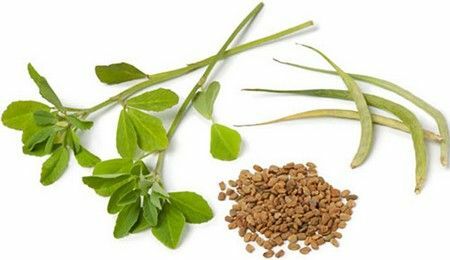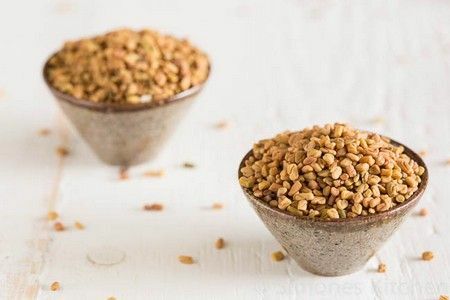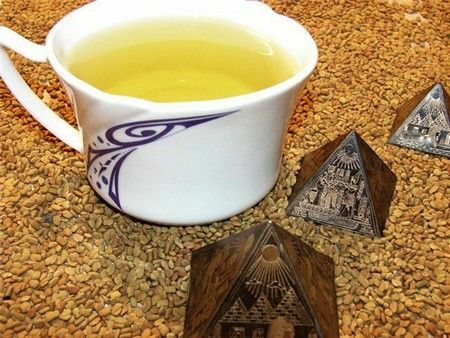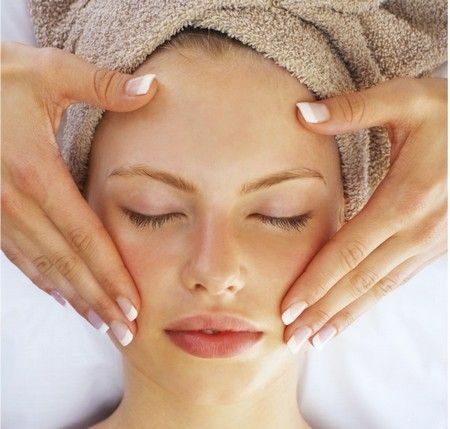- "Golden tea" from Egypt
- Female Secrets
 Application of fenugreek - fertile ground for the emergence of legends, which, unfortunately, is used by unscrupulous sellers and distributors of "outlandish" potions "from all diseases."Although this culture is more known in Russia as a fragrant herb in pasture for animals( the word "fenugreek" comes from an outdated "pasture", which has become a part of traditional poetic speech and means "pasture"), the modern craving for new and healing justifies consumers' interest in this notableamong other spices.
Application of fenugreek - fertile ground for the emergence of legends, which, unfortunately, is used by unscrupulous sellers and distributors of "outlandish" potions "from all diseases."Although this culture is more known in Russia as a fragrant herb in pasture for animals( the word "fenugreek" comes from an outdated "pasture", which has become a part of traditional poetic speech and means "pasture"), the modern craving for new and healing justifies consumers' interest in this notableamong other spices.
Meanwhile, in the countries of the South and East, fenugreek is an ancient herb that has a wide application from cult rites to folk medicine and cooking. It affects the number of "names" that people gave at different times to this unusual culture: Shamballa( India), Hilba( Arab countries), Fenugreek( Europe).Not less than the names of spice products made from it: Chaman( Armenia), Utskho-Suneli( Georgia), Methchi( India).

There is an assumption that fenugreek as a medicine and spice began its march on the planet from ancient China( about 3700 BC).On his way were India, the Arabian Peninsula, Persia and Egypt.
Mention of shamballa as a component for the rituals of the cult can be found in the papyri of ancient Egypt( about 1550 BC): it was used for embalming mummies as an incense. So, fenugreek seeds were found in the burial of Tutankhamun. To preserve their beauty and youth, Queen Cleopatra was helped by the means with this fragrant plant.
In ancient times, fenugreek seeds were one of the valuable medicines, as mentioned by Hippocrates and his followers( V and VI centuries BC).According to tradition, philosophers liked to chew the seeds of shamballa, for which the plant received the name "philosophical clover".
Shambhala is the only spice plant that "took part" in the war as. .. weapons. When the Romans seized Jerusalem( 66-70 BC), the emperor Vespasian, who led the troops of the conquerors, ordered the soldiers to storm the high walls of the "Holy City".As the historian Joseph Flavius noted, the defenders of Jerusalem threw fenugreek seeds containing a lot of mucus into hot oil, which made it very slippery. Tanks with boiling oil were tipped from above directly to the heads of the Romans climbing the stairs.
In the Middle Ages fenugreek came to Western Europe, it was used as a remedy for hair loss. Benedictine monks cultivated shamballa in their gardens. It is established that in the possession of the King of the Franks Charlemagne, this amazing culture was forcibly bred. The spectrum of the drug effect of fenugreek expanded - from the XI century.it was actively used in folk medicine for healing wounds, treating fevers, alleviating respiratory and digestive diseases. Later, many other useful qualities of shamballa were discovered, and it became widely used not only in medicine, cooking and cosmetology, but also in the textile industry as a dye.
"Golden tea" from Egypt
In Egypt, the "Helba" tea is very popular, or, as it is still poetically called, "Golden Tea".In this tea, fenugreek seeds have found application.
Thanks to the regular use of this drink, the skin not only on the face but also on the whole body becomes youthful, more elastic. Useful substances that are part of the tea from shamballa, give the skin a pleasant aroma, help to cleanse the body.

How to brew such tea from fenugreek?
Recipe: lightly fried fenugreek seeds pour boiling water( in the proportion of 3 teaspoons per 1 liter of water), hold on low heat for about 5 minutes. You can drink this tea 2-3 times a day on a small cup( 120 ml).Tip: For the aroma of shamballa to open in a drink in all its glory, it is necessary to attentively attentuate the frying of fenugreek seeds in a dry frying pan. Do this immediately before preparing the drink. When frying, you often need to shake a frying pan or mix shamballa so that the seeds do not acquire a reddish color - the tea made from such raw materials will be bitter.
Caution
Use of fenugreek inside has limitations only during pregnancy( I trimester, increased uterus tone), in case of any diseases accompanied by bleeding, and if there is a violation of the hormonal balance in the body.
Women's secrets
The mysterious and beautiful women of the East have used to know a variety of useful properties of fenugreek for a long time, applying it in various spheres:
- for preservation of attractiveness and health after childbirth;
- for the normalization of the hormonal balance;
- during lactation to enhance it;
- for cleansing the body, giving a pleasant "roundness" to the contours of the face and body, to get rid of cellulite;
- for face and hair care.
Fenugreek oil in cosmetology for beauty of face and hair
Oil extracted from the seeds of this plant has valuable antimicrobial and healing properties, so it can effectively cleanse the skin, fight inflammation and acne. It is important not to dwell on the first results, but to include the use of fenugreek oil in the procedures for regular facial care with the help - only so you can say goodbye to problems and skin irritations.
In addition, creams and masks intensively nourish and moisturize epidermal cells, which causes skin elasticity of the skin, wrinkles and traces of weathering, signs of fatigue and aging. Powder from fenugreek seeds acts as a soft scrub, effectively renewing skin cells.

. The prescription for a facial mask based on oil of fenugreek:
It is required: 0.5-1 tsp.oils of black cumin and fenugreek, 0.5 tsp.honey.
Mix the ingredients and apply on face and neck for 15 minutes, rinse with warm water.
It is claimed that women in the harems of the eastern rulers used fenugreek seeds inside to give their hair strength and shine
Beautiful hair, smooth, silky, obedient is a dream and a goal for every beauty. Oil, powder from ground fenugreek seeds for hair is a real elixir: they help to restore the structure of the hair, treat the tips of the tips, accelerate the growth of hair, eliminate dandruff and itching.
Prescription mask to activate hair growth:
It will be required: fenugreek oil( 10-20 ml depending on the length of the hair), if desired - other "oriental" oils - black mines, aml, ysmy.
Apply oil( or a mixture of oils) to the hair, put on a warming cap, after 1 hour, rinse the head thoroughly with natural shampoo.
Prescription mask with ground fenugreek for hair against dandruff and irritation:
It is required: 1 tsp.powder of ground fenugreek, 1 tbsp.olive and cumin oil.
Mix the ingredients, apply the mixture evenly on the hair, gently rubbing into the scalp. To warm your head, after half an hour or hour, wash it off.
Recipe for mask from ground fenugreek seeds:
It is required: 1-2 tablespoons.ground fenugreek seeds, some water.
Apply the slurry to the scalp, after an hour wash it off( you can leave it overnight).
Tip: You can take whole seeds, pre-soak out in water( 12 hours), mash into gruel and use as a mask for scalp.

Slender figure and. .. Appetizing forms
It is known that fenugreek is used for weight loss. How exactly? You can add 1 tsp.seeds for food, for example, in salads. Another way - before eating, drink 1 tsp.fenugreek seeds with water.
Mucus and oily substances that fenugreek develops, getting into the stomach, can gently envelop the mucous, improve digestion, and in addition, fight with heartburn.
Another interesting property of whole shamballa seeds - they perfectly absorb moisture, so they are recommended to eat in the morning on an empty stomach( 1-2 tsp half an hour before breakfast).Getting into the stomach, vegetable fibers swell, reducing the feeling of hunger.

The seeds of shamballa contain the substance diosgenin, stimulating the growth of mammary glands. This allows us to assume that fenugreek can be taken for breast augmentation. The fact is that the content of phytohormones in the powder optimally affects the woman's body, which can help increase the size of the breast without surgery.

How to apply fenugreek to increase bust? First, it is a tea made from powder with dates, figs of honey, lemon juice, mint, stevia leaves or favorite spices. Secondly, it is infusion of fenugreek onto the skin of the breast and carrying a light massage of the breast twice a day. You can mix the powder with a cream or lotion for the body and make nourishing masks on the skin of the breast.
Dairy rivers
Many young mothers sometimes have uncertainty about whether the milk is enough for the baby. It is precisely known that if a baby does not cry and sleeps quietly between feedings, then everything suits him. Nevertheless, at the stage of breastfeeding, it is possible to stimulate lactation with infusion of fenugreek - it is a hormonal process. The seeds of this plant contain natural substances like prolactin hormone, which contribute to the normalization of the natural production of milk, its saturation with useful elements for the growth and development of the baby.
How to consume fenugreek in order to establish a natural feeding? You can prepare a drink from the seeds or have the seeds as a whole, like Indian women do. Young mothers add fenugreek to sweet dishes, consume it with palm sugar. It perfectly tones up the body, promotes its rapid recovery after delivery, stimulates lactation.
How to brew fenugreek correctly to stimulate lactation? You can use the classic recipe for "golden tea", you can diversify it. To do this, in the teapot you need to pour the cooked broth, add 2-3 leaves of mint, lemon, honey to taste and even milk.

. Attention: With regular intake or exceeding of the dose, shamballa tea can provoke gas formation, allergies, and the skin of the mother( or the urine of the baby) will get the smell of maple syrup. This is not dangerous, but if at this point you need to pass tests or visit a doctor, you must certainly warn him, otherwise on this smell the doctor can judge about the presence of serious violations in the endocrine system.
On how to properly use fenugreek as a curative and revitalizing agent, you can learn from the video:
